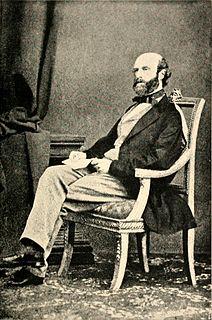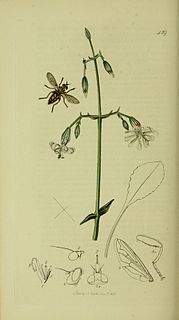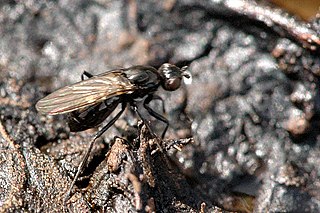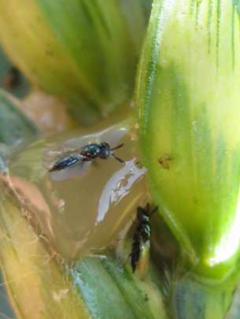
Chalcid wasps are insects within the superfamily Chalcidoidea, part of the order Hymenoptera. The superfamily contains some 22,500 known species, and an estimated total diversity of more than 500,000 species, meaning the vast majority have yet to be discovered and described. The name "chalcid" is often confused with the name "chalcidid", though the latter refers strictly to one constituent family, the Chalcididae, rather than the superfamily as a whole; accordingly, most recent publications (e.g.,) use the name "chalcidoid" when referring to members of the superfamily.

Alexander Henry Haliday was an Irish entomologist. He is primarily known for his work on Hymenoptera, Diptera, and Thysanoptera, but worked on all insect orders and on many aspects of entomology.

The Mymaridae, commonly known as fairyflies or fairy wasps, are a family of chalcidoid wasps found in temperate and tropical regions throughout the world. The family contains around 100 genera with 1400 species.

George Thomas Rudd was an English entomologist mainly interested in Coleoptera.

The Cheloninae are a cosmopolitan subfamily of braconid parasitoid wasps.

The Doryctinae or doryctine wasps are a large subfamily of braconid parasitic wasps (Braconidae). Numerous genera and species formerly unknown to science are being described every year. This subfamily is presumably part of a clade containing otherwise any or all of the Alysiinae, Braconinae, Gnamptodontinae, Opiinae and Ypsistocerinae, and might be most closely related to the last one of these. Whether the Rogadinae are also part of this group is not known.

Aphrosylus is a genus of flies in the family Dolichopodidae.

The Pediciidae or hairy-eyed craneflies are a family of flies closely related to true crane flies, with about 500 species worldwide.
Charles Haliday (1789–1866) was an Irish public health reformer, historian and antiquary who made significant contributions to the study of the history of Dublin, being particularly interested in the Scandinavian antiquities of the city.

An essay on the classification of the parasitic Hymenoptera of Britain which correspond with the Ichneumones minuti of Linnaeus is a Victorian monograph of entomology published in the Entomological Magazine between 1833 and 1838, by the Irish entomologist Alexander Henry Haliday.

The Euphorinae are a large subfamily of Braconidae parasitoid wasps. Some species have been used for biological pest control. They are sister group to the Meteorinae.

Themira is a genus of flies in the family Sepsidae.

Chorebus is a genus of parasitoid wasps in the family Braconidae. There are around 430 accepted species in the genus.

Telenomus is a genus of parasitoid wasps from the subfamily Telenominae. The genus was first described by Alexander Henry Haliday in 1833. Species in this genus parasitise the eggs or immature stages of other insects.

The Alysiinae are a subfamily of braconid parasitoid wasps with over 1000 described species. Several species have been used in biocontrol programs. They are closely related to the Opiinae.

Macroglenes is a genus of pteromalids in the family Pteromalidae. There are at least 20 described species in Macroglenes.

Colastes is a genus of braconid wasps in the family Braconidae. There are at least 80 described species in Colastes.
Binodoxys is a genus of parasitoid wasp of the subfamily Aphidiinae which are noted parasitoids of aphids. Its species generally prey on aphids which live on herbaceous plants.
Anaphes is a genus of fairyflies belonging to the family Mymaridae. It was first described by Alexander Henry Haliday in 1833.















